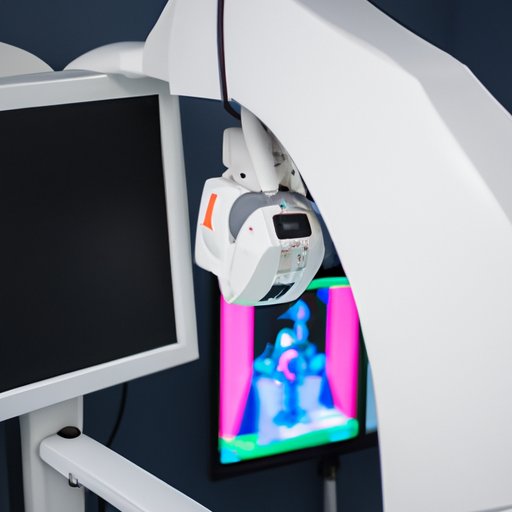Introduction
Technology has revolutionized nearly every aspect of modern life. From communication to transportation, technology has made our lives easier and more efficient. This is also true in the field of dentistry, where new technologies have enabled dental professionals to provide better care to their patients. In this article, we will explore how technology has changed modern dentistry and how new technologies are improving oral care.
Examining the Benefits of Digital X-Rays and Other Imaging Techniques
One of the most significant changes in dentistry over the past few decades has been the use of digital radiography. Digital x-rays allow dentists to quickly and easily view a patient’s teeth and gums with greater accuracy than traditional film x-rays. The American Dental Association (ADA) states that digital radiography “provides improved diagnostic capability, lower radiation exposure and improved patient comfort.”
Digital x-rays offer several advantages for patients. They are faster and more comfortable than traditional film x-rays, and they produce a clearer image. Additionally, digital x-rays can be stored electronically, making it easier to access and share information between dental professionals.
3D imaging is another technology that has become increasingly popular in dentistry. 3D imaging is a non-invasive technique that uses cone beam computed tomography (CBCT) to create detailed three-dimensional images of a patient’s teeth and jawbone. This type of imaging is especially useful for implant placement, root canal therapy, and other complex dental procedures.
Other imaging techniques used in dentistry include intraoral cameras and digital impression systems. Intraoral cameras are small cameras that allow dentists to take close-up images of a patient’s mouth, which can then be displayed on a monitor for easy viewing. Digital impression systems use 3D scanners to capture an accurate and detailed model of a patient’s teeth and gums, eliminating the need for messy, uncomfortable impressions.
Advances in CAD/CAM Dentistry
Computer-aided design and computer-aided manufacturing (CAD/CAM) technology has also had a major impact on modern dentistry. CAD/CAM enables dental professionals to design and fabricate custom-made restorations such as crowns, bridges, and veneers with greater accuracy and precision than ever before. The American Academy of Cosmetic Dentistry (AACD) states that CAD/CAM “allows for the fabrication of more esthetic and precise restorations in a fraction of the time it took with traditional methods.”
CAD/CAM technology offers several benefits for both dentists and patients. For dentists, CAD/CAM reduces the amount of time required to design and fabricate restorations. For patients, CAD/CAM restorations are more natural-looking and durable than traditional restorations. Additionally, CAD/CAM technology eliminates the need for multiple visits, as the entire process can now be completed in one appointment.
The Rise of Lasers in Dentistry
Lasers have become increasingly popular in dentistry in recent years. Lasers are used for a variety of dental procedures, including tooth whitening, cavity detection, and periodontal treatment. According to the Academy of Laser Dentistry (ALD), “Lasers are safe, effective, and can reduce pain and healing time compared to traditional treatments.”
There are several types of lasers used in dentistry. Soft tissue lasers are used for cosmetic procedures such as gum reshaping and frenectomies, while hard tissue lasers are used for cutting and drilling of teeth. Both types of lasers offer several benefits, including less bleeding, less pain, and faster healing times.

Utilization of Robotic Technology in Dental Procedures
Robotics is another area of technology that is being utilized in the field of dentistry. Robots are being used to assist with dental procedures, such as implant placement and root canals. These robots are designed to be highly precise, enabling them to perform complex tasks with greater accuracy than manual techniques.
Robotic technology offers several benefits for dental professionals and patients alike. For dentists, robotic technology enables them to deliver more accurate results with greater speed and efficiency. For patients, robotic technology reduces the risk of complications and minimizes discomfort during procedures. Additionally, robots can be programmed to perform routine tasks, freeing up dentists to focus on more complex cases.

Exploring the Benefits of Telehealth for Dental Care
Telehealth is another area of technology that is being utilized in dental care. Telehealth refers to the use of telecommunications technology to deliver health care services remotely. Telehealth has become increasingly popular in recent years due to its convenience and cost-effectiveness.
Telehealth offers several benefits for dental care. It allows patients to receive care from the comfort of their own home, eliminating the need to travel to a clinic or office. Additionally, telehealth can help increase access to care for those who live in rural or underserved areas. Finally, telehealth can reduce the cost of care by eliminating the need for in-person visits.
Conclusion
Technology has had a profound impact on modern dentistry. From digital x-rays and 3D imaging to CAD/CAM, lasers, robotics, and telehealth, new technologies are enabling dental professionals to deliver better care to their patients. By leveraging these new technologies, dentists can improve accuracy, reduce costs, and increase access to care.
(Note: Is this article not meeting your expectations? Do you have knowledge or insights to share? Unlock new opportunities and expand your reach by joining our authors team. Click Registration to join us and share your expertise with our readers.)
